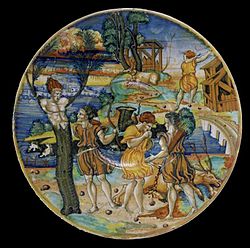Cyparissus


InGreek mythology,CyparissusorKyparissos(Ancient Greek:Κυπάρισσος,romanized:Kupárissos,lit. 'cypress') was a boy beloved byApolloor in some versions by other deities. In the best-known version of the story, the favorite companion of Cyparissus was a tamedstag,which he accidentally killed with his huntingjavelinas it lay sleeping in the woods. The boy's grief was such that it transformed him into acypress tree,aclassical symbolof mourning. The myth is thusaetiologicalin explaining the relation of the tree to its cultural significance. The subject is mainly known fromHellenizedLatin literatureandfrescoesfromPompeii.[1]NoGreek hero cultdevoted to Cyparissus has been identified.
Family[edit]
According to the grammarianServius(4th and 5th centuries AD), Cyparissus was the son ofTelephus,and thus the grandson ofHeracles.[2]
Mythology[edit]
As initiation myth[edit]

The myth of Cyparissus, like that ofHyacinthus,has often been interpreted as reflecting the social custom ofpederasty in ancient Greece,with the boy the beloved(eromenos)of Apollo.Pederasticmyth represents the process ofinitiationinto adult male life,[3]with a "death" and transfiguration for theeromenos."In all these tales," notesKarl Kerenyi,"the beautiful boys are doubles of [Apollo] himself."[4]
The stag as a gift from Apollo reflects the custom inArchaic Greek societyof the older male(erastēs)giving his beloved an animal, an act often alluded to invase painting.[5]In the initiatory context, the hunt is a supervised preparation for the manly arts of war and a testing ground for behavior, with the stag embodying the gift of the hunter's prey.[6]
Similarly, the myth was used to explain the connection of the cypress tree to mourning and sorrow. Forbes-Irving has argued that the cypress as tree of mourning was mostly a Roman tradition, with few evidence of it playing such a role in Greek society.[7]It is possible however that the earlier Greek source of Cyparissus's myth diverged significantly from the surviving later ones, and was originally used to explain the connection of the cypress to Apollo specifically.[7]
Ovid's version[edit]

The tameness of the deer may be the invention of theAugustan poetOvid,[8]and a late literary reversal of the boy's traditional role.[citation needed]Ovid's Cyparissus is so grief-stricken at accidentally killing his pet that he asks Apollo to let his tears fall forever. The god then turns the boy into acypress tree(Latin:cupressus), whose sap forms droplets like tears on the trunk.
Ovid frames the tale within the story ofOrpheus,whose failure to retrieve his brideEurydicefrom theunderworldcauses him to forsake the love of women in favor of that of boys. When Orpheus plays hislyre,even the trees are moved by the music; in the famous cavalcade of trees that ensues, the position of the cypress at the end prompts a transition to the metamorphosis of Cyparissus.[9]
The commentaries of Servius and the Vatican Mythographer[edit]

According to one of theVatican Mythographers,another Roman tradition makes the lover out to be the woodland godSilvanus.[10]An invocation byVirgilof "Silvanus who bears the slender cypress uprooted"[11]was explained in thecommentaryofServius[12]as alluding to a love affair. In his brief account, Servius differs from Ovid mainly in substituting Silvanus for Apollo, but also changes the gender of the deer and makes the god responsible for its death:
Silvanus loved a boy(puer)named Cyparissus who had a tame deer. When Silvanus unintentionally killed her, the boy was consumed by sorrow. The lover-god turned him into the tree that has his name, which he is said to carry as a consolation.[13]
It is unclear whether Servius is inventing anaition,a story to explain why Silvanus was depicted holding an evergreen bough, or recording an otherwise unknown version.[14]Elsewhere, Servius mentions a version in which the lover of Cyparissus wasZephyrus,the West Wind.[15]The cypress, he notes, was associated with theunderworld,either because they don't grow back when pruned too severely, or because inAtticahouseholds in mourning are garlanded with cypress.[16]
Cyparissus in Phocis[edit]
According to a different tradition, a Cyparissus, possibly not the same figure, was the son ofMinyas,and the mythical founder of Cyparissus (Kyparissos) inPhocis,which later was calledAnticyra.[17]
In botany[edit]
The wordCupressuswas used to describe agenusofcypress trees;this genus was first described in the 18th century by theSwedishbiologistLinnaeus.In modern times there is a taxonomic debate regarding which species should be retained in the genusCupressus.[18]
See also[edit]
Notes[edit]
- ^Cedric G. Boulter and Julie L. Bentz, "Fifth-Century Attic Red Figure at Corinth,"Hesperia49.4 (October 1980), pp. 295-308. The authors present a possible identification of Cyparissus on a fragment of aCorinthian pot,No. 36, p. 306. The frescoes in the Pompeiian Fourth Style are discussed by Andreas Rumpf, "Kyparissos",Jahrbuch des Deutschen Archäologischen Instituts63/64(1948–49), pp. 83–90.
- ^Brill's New Pauly,s.v. Cyparissus;Servius,Commentary on theAeneidofVirgil3.680.
- ^Bernard Sergent,Homosexualité dans la mythologie grecque,1984 (Chapter 2), with an introduction byGeorges Dumézil,whose lead Sergent follows.
- ^Karl Kerenyi,The Gods of the Greeks(Thames and Hudson, 1951), p. 140.
- ^Gifts of animals from theerastesare discussed as they appear in Attic vase-painting by Gundel Koch-Harnack,Knabenliebe und Tiergeschenke: Ihre Bedeutung im päderastischen Erziehungssystem Athens(Berlin 1983).[page needed]
- ^Koch-Harnack,Knabenliebe und Tiergeschenke.[page needed]
- ^abForbes Irving, Paul M. C. (1990).Metamorphosis in Greek Myths.Clarendon Press.p. 261.ISBN0-19-814730-9.
- ^Ovidtells the tale in theMetamorphosesX 106ff.
- ^Elaine Fantham,Ovid's Metamorphoses(Oxford University Press, 2004), p. 162.
- ^Ronald E. Pepin,The Vatican Mythographers,2008:17
- ^Virgil,Georgics1.20:et teneram ab radice ferens, Silvane, cupressum.
- ^Servius,note toGeorgics1.20 (Latin).
- ^Hic amavit puerum Cyparissum nomine, qui habebat mansuetissimam cervam. hanc cum Silvanus nescius occidisset, puer est extinctus dolore: quem amator deus in cupressum arborem nominis eius vertit, quam pro solacio portare dicitur.
- ^Peter F. Dorcey,The Cult of Silvanus: A Study in Roman Folk Religion(Brill, 1992), pp. 15–16. Servius also mentions this version in his note toEclogue10.26.
- ^Servius, note toAeneid3.680.
- ^Ergo cupressi quasi infernae, vel quia succisae non renascuntur, vel quia apud Atticos funestae domus huius fronde velantur.
- ^Stephanus of Byzantium,s.v. «Aπολλωνία» and «Κυπάρισσος».Real EnzyclopädieVIII, col. 51, s.v. «Kyparissos» [Hirschfeld].
- ^C. Michael Hogan and Michael P. Frankis. 2009[full citation needed]
References[edit]
- Brill’s New Pauly: Encyclopaedia of the Ancient World. Antiquity, Volume 3,Cat-Cyp, editors: Hubert Cancik, Helmuth Schneider,Brill,2003.ISBN978-90-04-12266-6.Online version at Brill.
- Servius,Servii grammatici qui feruntur in Vergilii carmina commentarii,Volume I, edited by Georgius Thilo and Hermannus Hagen,Bibliotheca Teubneriana,Leipzig, Teubner, 1881.Internet Archive.Online version at the Perseus Digital Library.
External links[edit]
 Media related toCyparissusat Wikimedia Commons
Media related toCyparissusat Wikimedia Commons



